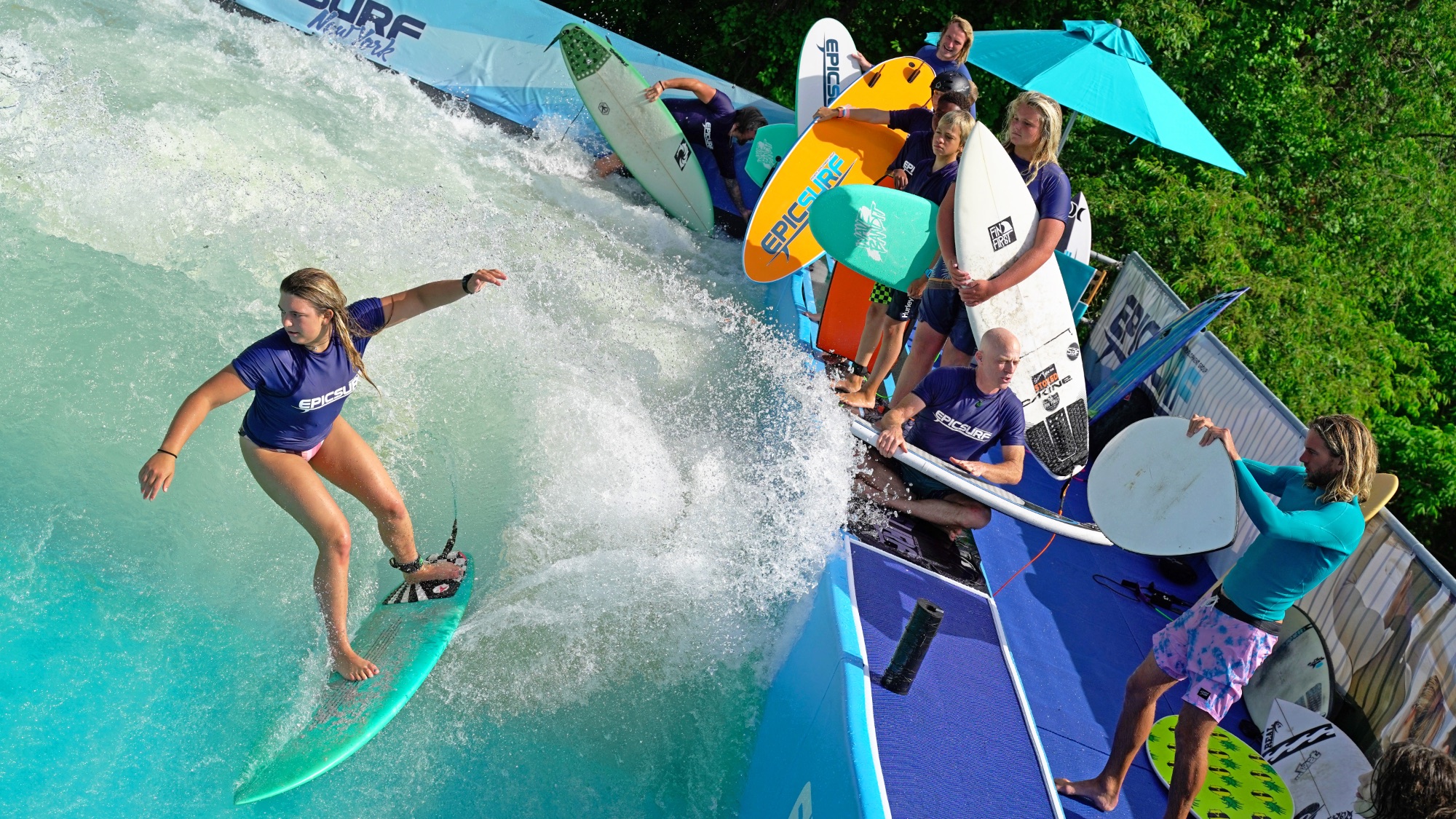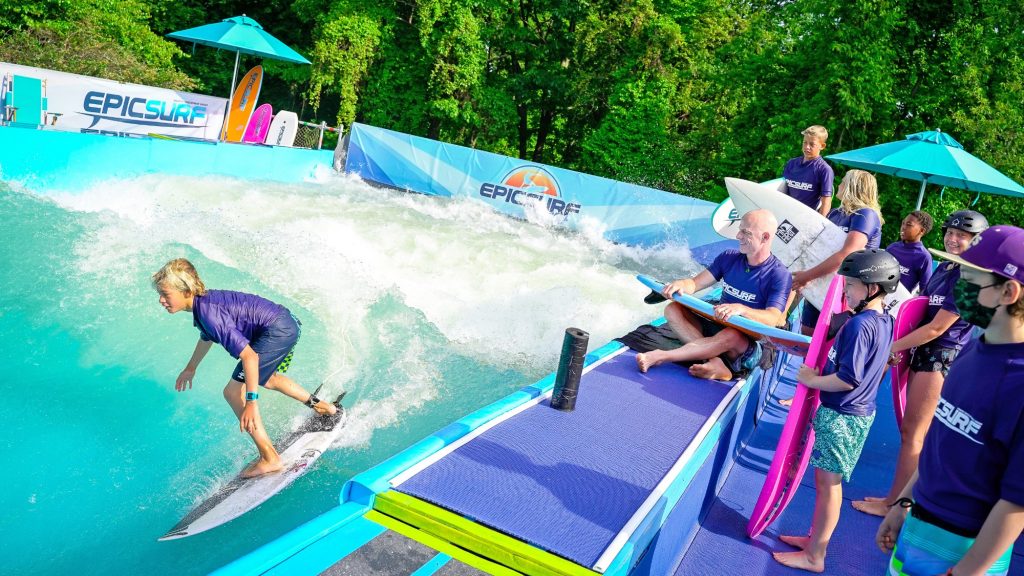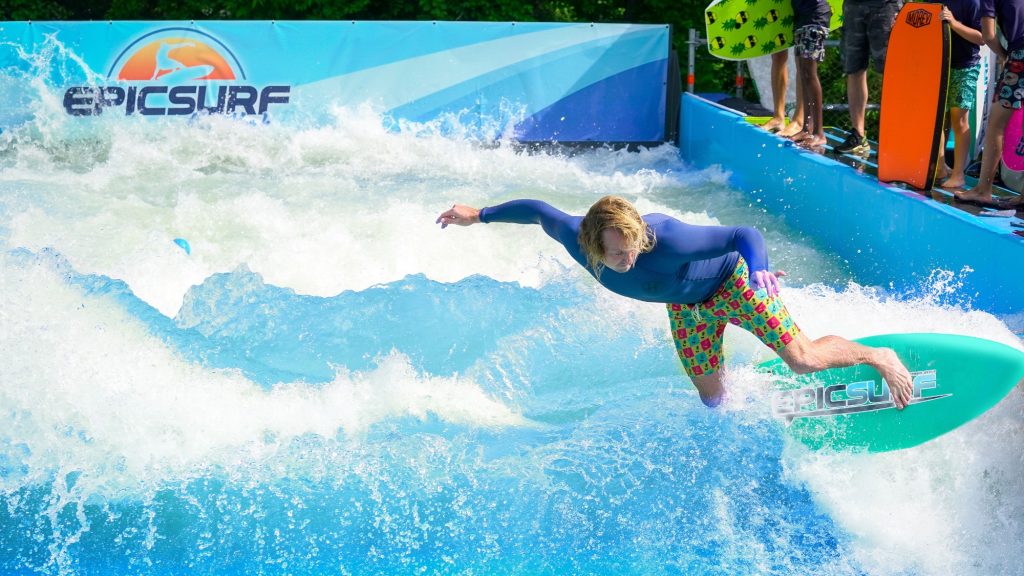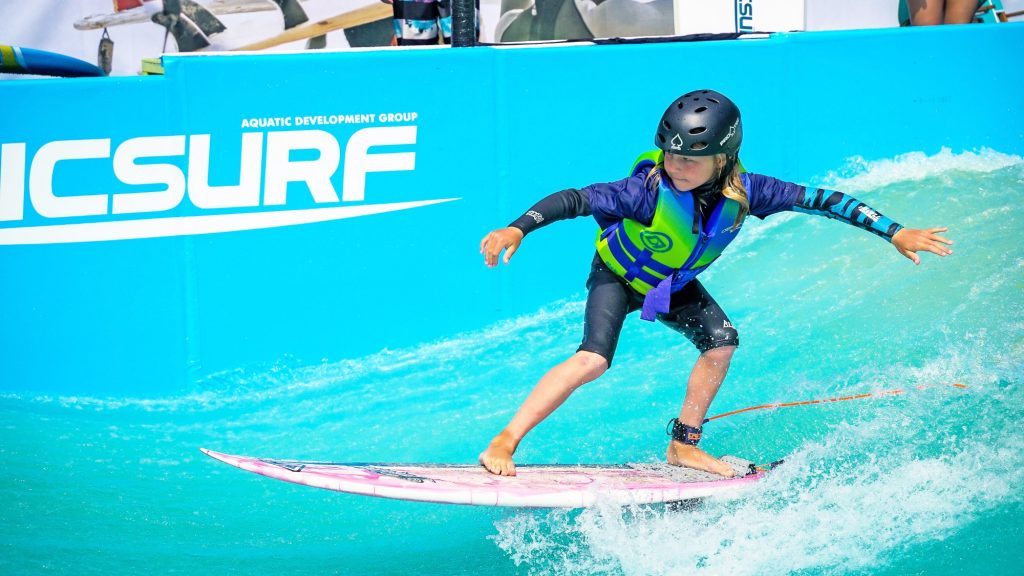ADG maps course on the heels of EpicSurf launch

Legacy wave pool company Aquatic Development Group, or ADG, has its pneumatics in several wave pool systems across the world. You just might not recognize them. On the surf culture side, the opening scene from the classic The North Shore was filmed at Oasis in California at one of ADG’s pools. In our view, this totally cements the company name in the wave pool hall of fame.
On the biz side, ADG is a team of builders, engineers, designers all with, as the company says, skills for observing and bringing their proven business acumen into the picture.
Through the ‘80s and up to today, ADG has had its hand in everything from aquariums to movie sets, all powered by their WaveTek wave systems. Their technology can be found in projects including large wave pools of all shapes and sizes to shallow kid’s pools and traveling river waves. Boiled down, it’s the same engine used to power wave pools around the world.
ADG recently launched EpicSurf, a stationary deep water wave that allows users to session on traditional surfing equipment – full-sized boards with fins. The company notes that they are excited to bring EpicSurf to market and do their part to make surfing more accessible.
Jim Dunn, ADG’s President, shared with us the history of the company’s wave pools, how the space has evolved, and where he sees the industry may be headed.

Can you give us a brief history of ADG outside of wave pools? In other words, what’s else do you do?
ADG’s roots reach back to the 1950s where we started designing & building commercial pools. In the early ’80s when water parks were first coming to life, we were there, with our wave systems as well with our design and construction crews. Since then, we have grown into one of the world’s most respected water park and recreational design, construction, and manufacturing firms in the industry. We offer a full suite of products and services from water filtration and wave systems, to full-blown indoor, outdoor, and resort water park design/build projects. Our products are in over 4,000 facilities worldwide. We have designed, engineered, and constructed more than 100 indoor and outdoor waterparks and have over 500 wave pools and specialty wave systems installed around the world.
So we’ve been involved in a lot of projects and the one thing everyone rather quickly comes to realize is that while you might create something where, sure, people can come and they can have fun if the business isn’t sustainable, it’s not going to work. So that’s where we start. We get into the conversation about the relationship between attractions, design, and operations and how they can best fit together to form a healthy business that works both for your guests and for your bottom line.
And within the wave pool world?
ADG’s advancements in waves have led to many new and emerging technologies – from standing and sheet wave attractions to surf pools and rivers – that have quickly become the industry standard for use in recreational and surfing applications. We created the first set of hydraulic surf pools in North America in the early ’80s which proved that man-made surfable waves were a real thing. We were also first with energy-efficient pneumatic wave systems, proving that they could produce large, consistent waves that held their shape. We built the first surfable pneumatic wave pools in the mid ’80s, including Oasis Point, which was the setting for The North Shore, as well as Wild Rivers in CA, that hosted of the 1988 Pro Inland Surf Tour. In the early 1990s, at Festival Bay, we built the first full-scale model of a purpose-built pneumatic surf pool. Since then we have gone on to build hundreds of recreational wave pools and rivers for the waterpark industry. At the time that’s where the demand was. Where the business was headed, and we charged ahead making our niche.
You use the same WaveTek system you use in your wave pools to power other types of nonrecreational wave pools, correct?
Our systems have gone into everything from fountains to aquariums, to movie sets,. You know, building wave pools for the public versus building it for kelp or coral, well, there’s a lot of varying criteria. And I think the wonderful thing about it is that we have the ability to shape the pool itself to create something very successful for every application. The wave action in the Life of Pi movie for example might not look great for surfing, but that’s because the pool was not designed to make surf waves. It was designed to recreate ocean swells. And so the pool we built is flat bottomed and actually has some obstacles in it to help recreate stormy ocean swells. But that same wave generator is also very capable of creating the initial wave action to create a wonderful surfing wave. It has to do with the bathymetry between the shape of the pool and the waves

Those systems are quite different from your new EpicSurf deep-water standing wave design.
When we started to take a closer look at the surfing industry and where it was today, we looked at it not only from a wave manufacturing perspective but from our experience in building places, businesses,, we think work. What was missing? What would be an asset to surfing? We also thought about all those people who can’t surf How are we going to support them and get them drawn into an experience that makes them not only want to try, but want to come back? And so we really started to work on not just focusing on an experienced surfer, but focusing on a full range of guests. EpicSurf is a really excellent wave for an experienced surfer. But we’ve also figured out a way to take it down a notch, to make it easier for someone to get on and just learn it all.
We sent a reporter to try it out and she said she’s never had so much fun in a parking lot before.
That’s great to hear. You know, we started building this prototype in our parking lot last September and we began testing in December. We had people here watching in 20F degrees, bundled up, and then we had professional surfers like Ben Gravy and Blair Conklin riding the wave and giving us feedback on how we can make the system perfect for beginners and for experts. So we kept making tweaks and adjustments. We tested again in February. Then in spring, and throughout the summer, we had multiple events with 30+ people here at a time. We looked at the interaction between the surfer and the wave, between the guests with one another. How is the water flow? How are the cue lines working, are people getting on and off alright? The best thing we discovered, truly, is how much camaraderie there is in the community. It’s exciting to meet all the personalities and observe how they work together and surf together. I mean, you’re getting professional surfers and wakeboarders here, having a blast carving it up on the wave, and then the next minute jumping off to help other kids get on the wave. And with a smile on their face the entire time. We’ve been researching and practicing and discovering, and it’s just been a whole lot of fun. We’ve developed an experience that we really think is complementary to the whole industry.

What are you most proud of with EpicSurf?
Honestly, it’s the inclusivity. I mean, this wave brings you up close and personal, you become a part of the action, whether you’re just watching or actively participating. And one thing that we really see as a big opportunity within the surf industry today is helping build that participation. We had one guest, a child, who had a surf lesson in the ocean but never got to practice because he didn’t make it back to the beach regularly. So now he gets on the EpicSurf, starts off holding onto the training bar, and then when he got off, he’s yelling ‘I’m doing it’!’ I mean you could literally see the excitement in his face and feel like you were a part of it. Because you were right there experiencing the joy with him. And then when someone does have the opportunity to get in the ocean, they have this surfing experience already and they can continue to build more skills. So it just really kind of all fits together to help build the sport and build the industry.
Where is ADG heading in the future?
What you can expect from ADG is a constant focus on and improvement in overall guest experience and technology, whether that be from direct interaction with our products or from more passive spectator participation. If you look at our history, we’ve always continued to evolve. We’ve improved our technologies and offerings. We have a better understanding of our client’s businesses and operations today than we did twenty years ago, or 10 years ago, or even five years ago. And we continue to enhance and improve our offerings to meet their needs. We’re already talking about what’s next with EpicSurf for example. We’ve already started asking ourselves, how can we continue to build on this experience and make it better? I mean, wouldn’t it be nice if when after you’ve surfed a session, the system automatically knows your preferred wave heights, surfing times, number of waves you caught and has accounted for your feedback so that the next time you showed up everything was customized just by you? It’s something we are looking at putting together now.
Related Coverage
